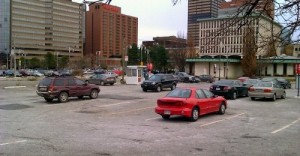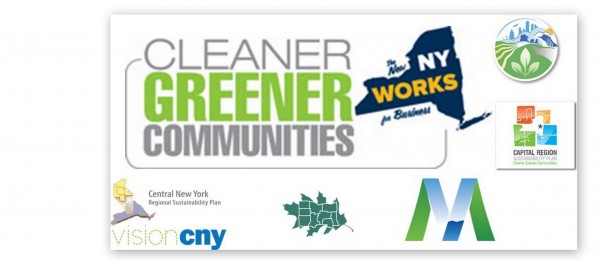The Cleaner Greener Communities (CGG) planning efforts, run through the New York State Energy Research and Development Authority (NYSERDA) and launched late last year with $10 million in funds, are nearing completion. All ten regions have completed regional greenhouse gas inventories and utilized the findings to formulate regionally appropriate sustainability visions. With the assistance of qualified and dedicated professionals and citizens, specific targets have been created in the areas of land use, economic development, air and water quality, transportation, energy, waste management and agriculture.

The regional sustainability plans call for steering new development to existing centers and infrastructure
Although it would have been ideal if the CGC effort was completed prior to two rounds of REDC funding, the CGC plans are now ready to assist the REDC Councils in recognizing the imperative nexus between economic development, land use, “location efficiency” and energy and environmental goals. Anointed by NYSERDA as “smart growth plans”, every CGC plan incorporates regionally appropriate smart growth principles and practices: compact, mixed-use development focused on existing infrastructure and centers; decreased dependency on the automobile and provision of multi-modal transportation options; preservation and protection of agriculture and farmland, and community character and heritage. Many of the indicators proposed are essentially measures of location efficiency: land consumed per capita, vehicle miles traveled, and percentage of persons living in existing centers.
Empire State Future sees in these plans the metrics that can get New York to work. While they are set to guide the competition for the $90 million of Regional Greenhouse Gas Initiative funds, we feel they can do more. In April, each REDC Council– many which contain new faces since beginning two years ago — will be presented on the findings of the CGC efforts. The Councils will have the opportunity to embrace the goals and metrics coming out of the CGC effort to improve their analysis of the priority projects they put forward for the competition of $760 million of REDC funds, awarded annually. NYS agencies and authorities can also lead by example by incorporating the most relevant metrics into their scoring criteria for REDC projects as well as the $20 billion-plus in infrastructure and capital expenditures the new New York invests annually. This would further reflect a commitment to state law as embodied in the Public Infrastructure Policy Act – a law that passed in 2010 overwhelmingly in both the NYS Senate and the NYS Assembly.
Cleaner Greener Communities has the opportunity to be more than a stand-alone effort. As it now stands, it is the poor cousin in the shadows of the REDC effort. The REDCs have created a regional framework in which independent entities — local governments, businesses, civic leaders — come together to think broadly about a regional vision. This has brought new energy to many regions tired of planning without results. Extending the new CGC metrics into the REDC scoring can put New York State and all of our respective regions on the path to greater, greener, and lasting economic success.
Here are some examples of encouraging and ambitious targets being set by the multidisciplinary planning groups.
-
The Sustainable Capital Region Plan targets include reducing per capita energy consumption 20% by 2020. By 2030, the goal is to reduce annual per capita consumption of land by 5%; the percentage of households with combined housing and transportation costs exceeding 45% of income by 10%, and single-occupant-vehicle miles 25%.
Each of the ten regional sustainability plans strives to reduce automobile use and dependency. Photo: Newsday
-
The Finger Lakes Regional Sustainability Plan presently calls for reducing regional carbon dioxide emissions 15% by 2025 and 35% by 2035; the amount of transportation energy used per capita 10% by 2020 and 25% by 2035; vehicle miles traveled per capita from 9,700 in 2010 to 7,310 in 2050; and poverty rate in population centers from 23% to 18% between today and 2050. The plan targets increasing the percentage of regional residents living in centers from 36% today to 46% in 2050.
-
The Mid Hudson Sustainability Planning Consortium has hundreds of working group members and regional participation through a lively interactive on-line effort called Engage MidHudson. At the website, participants log in suggestions for the sustainability plan, and vote on and register their opinions about ideas proposed. The site even offers prizes–such as salsa dancing lessons!– for online participation.The plans targets include: increasing the percentage share of new housing units in multifamily buildings from 20% today to 28% in 2035; reducing vehicle ownership registrations per 1,000 capita 5% by 2035; cutting transportation fuel consumption 15% by 2020; and “lowering the fossil fuel intensity of the built environment” by 15% by 2020, 50% by 2050.
-
The Central New York Plan–VisionCNY–was launched in June. Onondaga County’s recently completed and launched sustainable development plan guided the Central New York effort. Targets in the draft plan include a very ambitious increase of population living in existing municipal centers from 41% today to 65% by 2030; and decreasing per capita land consumption 10% by 2030 (this figure had doubled in the region in just fifteen years).
- The Western New York Sustainability Plan, recognizing the region’s particularly sprawling land use patterns in the absence of region-wide population growth, has also targeted reducing land developed per capita. To accomplish this, they’ve set another measure: to have five municipalities in the next five years–one in each county–revise their comprehensive plans and zoning codes to incorporate smart growth principles, policies and practices.
- The Mohawk Valley Sustainability Plan, also recognizing the high costs that stem from inefficient land use, have set a target to reduce the average percentage of overall income paid per household on housing and transportation from 53% today to 43% by 2025; related is the target to reduce vehicle miles traveled per capita by 10% by 2025. In addition, the plan strives by 2015 to increase from four to eleven the number of community centers within the region that receive state Main Street Program funding; and increase four-fold by 2015 the number of communities taking advantage of state Brownfield Opportunity grants.
-
New York City’s PLANYC sustainability blueprint guides the cities effort at reducing GhG. The additional funding from CGC allowed the NYC Department of Planning to expand the efforts. They have already begun to implement new zoning practices.
Other regions have yet to release formalized targets but are moving in the right direction. The North Country’s draft “Homegrown North Country Sustainability Plan” aims to reduce the 40% of transportation-related greenhouse gas emissions in the region by concentrating development in existing town and village centers, improving transportation alternatives to the single-occupant vehicle, and by updating comprehensive land use plans. The Southern Tier Plan has selected regionally appropriate indicators, including: total percentage of regional workers commuting by carpooling, foot, bike or transit; regional gasoline sales; and number of residents living in cities and villages, among others. Despite the setbacks from Superstorm Sandy, the Long Island team, which includes ESF coalition members Regional Plan Association and Vision Long Island, will release their draft plan in the near future with special attention to climate adaptation.
These important plans are all still in draft form. There is still opportunity for you to get involved and become an author of your region’s sustainable future! As highlighted in the Hudson Valley Cleaner Greener plan, let’s make all growth smart growth!
This piece has been authored by Evan Lowenstein, ESF Consultant and David Hogenkamp, ESF Project Manager




